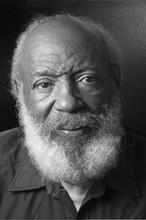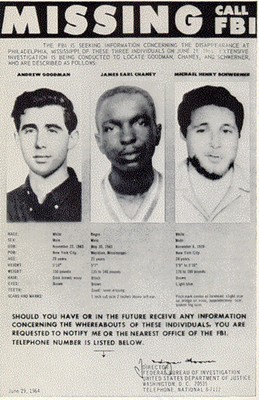United States Post Office
Introduction
Text-to-speech Audio
Images
The U.S. Post Office building was erected in 1933. It housed the U.S. District Court for the Southern District of Mississippi until 2012. The building is historically significant for its connection to two important civil rights cases, Meredith vs. Fair and United States vs. Price.
.jpg)
James Meredith (b. 1933) filed a lawsuit against the University of Mississippi in 1961 for barring him from enrolling into the school. The case became a pivotal moment in American Civil Rights history. Meredith eventually won and enrolled at the university.

Known as the "Mississippi Burning" murders, the killing of three civil rights activists in 1962 and the subsequent trial became a turning point in the Civil Rights Movement.

Backstory and Context
Text-to-speech Audio
United States Post Office
The Post Office is the city's second federal building. The first, a brick structure that featured a tower, was built in 1898 and demolished in the 1950s. The present building was built in 1933. Local architect P.J. Krouse designed it in an understated version of the Art Deco style. As such, the Post Office is less decorative than other Art Deco buildings in the city. The three-story building features a limestone exterior, bronze grills depicting ears of corn above the three main entrance doorways, and a parapet along the top with a repeated eagle and steer designs.
Meredith vs. Fair
James Meredith (b. 1933) filed the lawsuit against the University of Mississippi on May 31, 1961 at the Post Office and Courthouse with assistance from the NAACP Legal Defense and Educational Fund. At that time, the university only admitted white students. Prior to taking his case to court, Meredith applied to the school twice but was rejected both times. In September 1962, the case reached the U.S. Supreme Court, which supported the decision given by the Fifth Court of Appeals, which had previously ruled in Meredith's favor. On September 30, Meredith finally enrolled in the university. The event sparked a riot that night, which prompted the federal government to send troops of the Mississippi National Guard and U.S. Army, as well as U.S. Marshalls, to Meridian to restore order. Hundreds were injured and two were killed. Meredith eventually graduated but was under 24-hour protection during the entire time he was there.
United States vs. Price
On the evening of June 21, 1964 a group of white men murdered civil rights activists Andrew Goodman, Michael Schwerner, and James Chaney. Goodman and Schwerner were both white; Chaney was Black. All three worked for a civil rights organization called the Congress of Racial Equality. In June 1964, they were registering Black voters throughout Mississippi as part of an effort called Freedom Summer. On May 25, the men gave a talk at Mount Zion Methodist Church in the town of Longdale, Mississippi, encouraging the congregation to register to vote. Local KKK members learned of the registration drive and burned down the church (that summer, Klan members burned down 20 Black churches in Mississippi).
On June 21, the three men traveled from Meridian to Longdale to investigate the ruins of the destroyed church. On the way back, they got a flat tire near the town of Philadelphia. Despite this, they drove fast, hoping to return by 4:00 p.m., when they planned to be back in Meridian. However, Deputy Sheriff Cecil Ray Price (who helped coordinate the murders), pulled them over. Chaney, who was driving, was arrested for speeding and all three were taken to the Neshoba County jail, where they were held until around 10:00 p.m.
While driving back to Meridian on Highway 19, the white men spotted them. They were in two cars; one of them broke down but they other followed Chaney, Schwerner, and Goodman's car. The pursuers caught up to them and forced them to drive back towards Philadelphia and onto a country road. There, the white men beat and shot all three activists. They were taken to a few miles away to earthen dam and buried there. Their car, a station wagon, was abandoned on a logging road and set on fire.
The men were reported missing and their disappearance quickly attracted national attention and the FBI was ordered on the case. The car was found on the 23, but their remains were not found until August 4, after law enforcement received a tip from an informant. Claiming insufficient evidence, local and state law enforcement officials did not bring murder charges against the perpetrators. The federal government could not bring murder charges either because the crime was covered under state law. As a result, the U.S. Justice Department charged the men of violating the victims' civil rights.
It wasn't until February of 1967, that progress on the case moved forward. On the first day of the trial, which was presided by Judge William Harold Cox, dismissed a defense attorney's questioning of a witness about whether Schwerner plotted to rape women in 1964. This was a key moment, as it indicated that Cox would not favor the white men. During the trial, which took place at the Post Office and Courthouse building in Meridian, the sequence of events were revealed. As stated above, only seven men were found guilty. However, none served more than six years in prison. The murders and national attention the incident caused contributed to the passage of the Civil Rights Act of 1964.
Sources
Bentley, Michael. "History Yields to Economy as the Federal Courthouse in Meridian is Set to Close." January 2013. https://caba.ms/articles/features/meridian-courthouse-closing.
Cagin, Seth and Philip Dray. We Are Not Afraid. New York: Bantam Books, 1988.
"Case Profile: Meredith vs. Fair." University of Michigan Law School - Civil Rights Litigation Clearinghouse. Accessed January 13, 2020. https://www.clearinghouse.net/detail.php?id=11088.
Foner, Eric and Garraty, John A., eds. The Reader's Companion to American History. Boston: Houghton Mifflin, 1991, pp. 424–425. https://archive.org/details/readerscompanion00fone/page/424/mode/2up
"Murder in Mississippi." PBS - American Experience. Accessed January 13, 2020. https://www.pbs.org/wgbh/americanexperience/features/freedomsummer-murder.
Odom, Ila Ree. "United States Post Office and Courthouse." National Park Service - National Register of Historic Places Nomination Form. May 17, 1984.https://npgallery.nps.gov/GetAsset/db208c3f-84ea-40d4-a59f-eee94aa3f654.
Robertson, Campbell. "Last Chapter for a Court With a Place in History." The New York Times. September 17, 2012. https://www.nytimes.com/2012/09/18/us/mississippi-courthouse-with-rich-civil-rights-past-set-to-close.html.
U.S. Post Office, by Michael Barera, via Wikimedia Commons: https://commons.wikimedia.org/wiki/File:Meridian_December_2018_28_(United_States_Post_Office_and_Courthouse).jpg
James Meredith, via Wikimedia Commons: https://commons.wikimedia.org/wiki/File:James_Meredith_Portrait.png
Missing poster of Schwerner, Chaney, and Goodman, via Wikimedia Commons: https://commons.wikimedia.org/wiki/File:FBI_Poster_of_Missing_Civil_Rights_Workers.jpg
